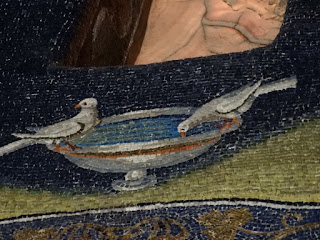 |
| dolphin mosaic San Vitale Ravenna |
Faithful tom tom lead me dutifully from Verona to Ravenna without incident and by mid day I had arrived at the Casa Paola B&B near the centre of the old town. With no street parking available I rented garage space for the next couple of days as transport is not needed as most sights are easily reached by walking or biking. The B&B is a lovely old house on three floors with huge beautifully appointed bedrooms and bathrooms and the common areas displaying what I assume to be the art collection of the owner with also a comprehensive library of art reference books. Access to the cool green garden is always available and guests also have access to a well -stocked wine fridge- at no charge.
The city of Ravenna was the main political and cultural centre of the West in the centuries during the decline of the Roman Empire and close to the Adriatic coast and also located on the fertile Po river delta it was well placed strategically and re trade and agriculture. It had been a city of canals but these were closed at the end of the 15C to build imposing and beautiful public squares like the Piazza del Popolo. With winding streets opening out into a series of elegant piazzas it is a wonderful small city with the most stunning cultural legacy, the mosaics, from its pre and post byzantine history. Ravenna is a UNESCO World Heritage site with eight monuments of particular consequence.
With only two days to explore I wasted no time lingering at the B&B and with map in hand set off to the tourist office to get the low down on opening hours and to plan my approach to the visit. The office staff are incredibly helpful and suggested that I purchase a card allowing entry to five sites and another for the remaining three. The Basilica of San Vitale and the mausoleum of Galla Placida are close in proximity to each other and my first stops.
Galla Placida’s mausoleum is apparently the oldest intact monument of its kind and constructed in the second half of the 5 C in the redbrick common to the buildings of the region. Entering the space I experienced a jolt of awe and delight at the glittering magnificence of the lavishly mosaicked dome, vaults and lunettes with only the lower walls uncovered. The vibrant colour and glittering light reflected from hundreds and thousands of tiny pieces of glass and gold speak clearly to us from the 5 C with scenes of Christ the redeemer exquisitely juxtaposed with floral and fruit motifs, pastoral scenes and delightfully, two blue birds sipping from a dish.
The ceiling depicts the night sky studded with jewel like stars and I wondered if Giotto had at some time visited, which may have inspired his own starry sky in the Scrovegni Chapel of Padova! Galla Placida was the adventurous daughter of King Theodoras who after his death ruled as Regent over which time her mausoleum was built. She was however never interred there.
On to nearby San Vitale, octagonal in shape with massive marble columns supporting the central dome. Mosaics covering the walls and vault of the presbytery and the conch of the apse are both religious and secular in subject matter with particular homage to the Emperor Theodoras his Empress and court as well as references to bishops and bible stories. Most of the glass in the mosaics was manufactured close by but there is little known of the artists who created them. I considered how difficult it must have been to be suspended at a great height, at first to outline the various compositions and then to painstakingly place the pieces with an eye to how the light would reflect colour and movement. My own neck was stiff after just a couple of hours gazing upwards so what a physical feat to work all day looking up!
In regard to all eight sites it is incredible how the artists captured expression, movement and the texture and folds of clothing in such a static medium and that these wonderful creations have remained fresh and vibrant for almost two thousand years. I particularly love the animals, trees, flowers and fruit in the earlier mosaics from the time of the king Theodoric a wise and religiously tolerant ruler. After his death Justinian a far more religiously doctrinaire monarch presided over a period when art reflected a new narrowness through more static and flat figures and less realism. At San Appollinare Nuovo these different styles are represented in juxtaposition.
I managed also to visit the marvelous Neonian Baptistry and the Duomo museum and Chapel of San Andrea before I called it quits for the day. The ideal approach would be to spend at least four days in Ravenna and devote half a day to each site, as the richness and glitter is quite overwhelming and should be savoured.
Wandering back through the lovely cobbled streets one notices regular signs that relate the Ravenna travel notes of famous writers and philosophers including Byron, Henry James, Oscar Wilde, Karl Jung and Goethe, underlining the inspiration and magic evoked by Ravenna over centuries.
Back at the B&B I treated myself to a glass of ice cold white wine enjoyed in the garden- it was still quite hot and humid before setting off for a pizza just down the street. I had selected to sit outside to enjoy a sea breeze but was driven inside by the smoke from other diners where delightfully I discovered the proprieter listening to opera while she both cooked and served. Great pizza and ambience and a lovely way to end the day.













No comments:
Post a Comment